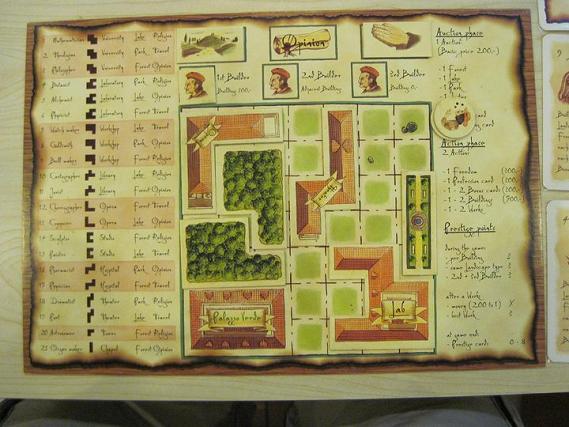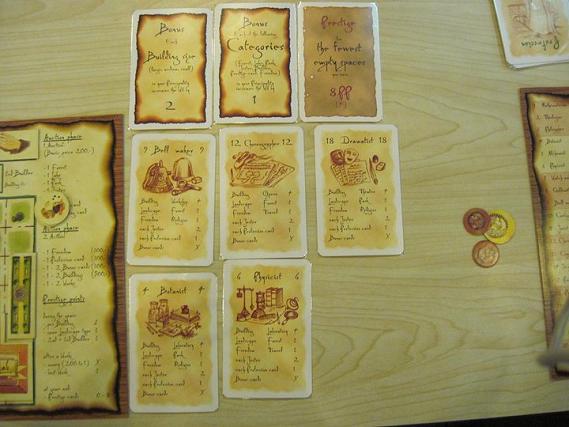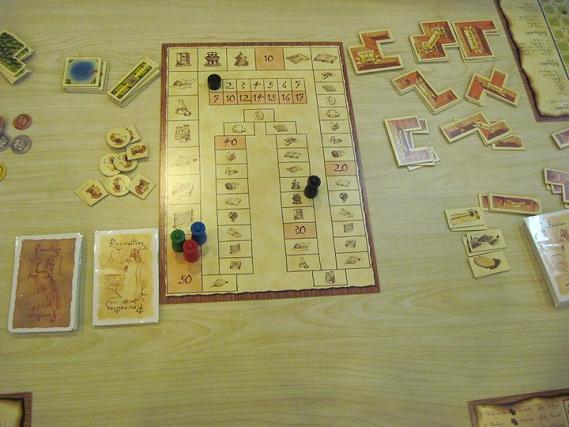
The Princes of Florence is one of those games from Alea that have always struck me for how classy their boxes look. The colors, artwork and general style look so stately and luxurious that they wouldn’t seem out of place in a university library. The actual contents of the boxes however tend to be more underwhelming and in the case of Princes of Florence, a bit bland. The colors are very muted, perhaps to make them look like pieces of an ancient parchment. Personally, I’d have preferred a more vibrant look as the Renaissance was a hotbed of innovation. After all in a game in which you’re supposed to be creating works of great artistic and scientific merit, you’d expect something with a bit of grandeur.
In this game, the players take on the roles of Renaissance princes who compete with each other to win prestige by creating magnificent works. The game is old enough that explaining the rules in detail would be a waste of everyone’s time but the basic idea is that each player develops his own city on his own personal board, sort of like Agricola. They then play profession cards which are worth a varying number points depending on whether the requirements on the cards match what the players have in their cities.
One thing that wasn’t immediately obvious to me is how few actions you actually have in this game. Every game lasts only seven rounds in total and each player has two actions per round, for a total of fourteen actions across the whole game. Each player starts with three profession cards in hand but according to Sean at the end of the game each player should complete an average of five works. Since drawing additional profession cards is a separate action from playing them, this means that you’d need to spend seven of your actions just to draw and play those cards. That doesn’t leave a lot of room for maneuver.

Of course, the auction phase at the beginning of every round could be thought of as an additional action as well since every player gets something out of it. One problem I have with this part is that it’s not very intuitive. You can buy buildings with a normal action but you can only get landscape pieces like lakes and forests through auctions? Holding auctions for jesters, prestige cards, recruiting cards and builders can be rationalized as representing unique talents of which only one of each is available per turn, but what’s the deal with the landscape stuff? Obviously there are good balance reasons for doing things this way, but this is the kind of thing that contributes to discrepancies between a game’s rules and its theme.
These caveats aside, I have to say that The Princes of Florence is an excellent game in the classic Euro style. Both my wife and myself were immediately impressed enough to consider buying it but after some reflection, the auction mechanics probably wouldn’t work well for two players. I particularly like that the use of cards introduces an element of randomness but because you typically draw five cards and get to choose one to keep, the randomness is very controlled. There are also a very low number of cards, so I’d imagine that in a game with more players, there’s an incentive to fight over them.
Other good points are that despite a strong strategic element, there’s no analysis paralysis at all, so the game flows very smoothly. The slowest part of the game will probably be when players have to decide whether or not to jack up the auction price for something that is being fought over but this is a great form of interaction and conflict. Otherwise, choosing what to do as an action is quite straightforward as you’re likely to have planned out what to do far in advance while still being very meaningful. I don’t agree with the lack of interaction complaints either as the auctioning process, vying for the best work award and paying attention to what others are doing are all quite important.

My only worry about its longevity is that perhaps the early rounds might become too mechanistic. Wouldn’t all players always fight over the limited freedoms over the first couple of rounds? But I’m probably overreaching to think too much about such problems after just one play. Like other games such as Puerto Rico, the main difficulty is really finding enough people interested in playing this as it’s such an old game with well understood strategies, especially when you need as many as five players to have the optimal group.
4 Responses to “The Princes of Florence”
I own this game. Personally, I think it’s a lot of fun, but I feel that it does suffer a bit from a lack of replayability. Eventually I came to the realization that by the third turn or so, I could plan out the rest of my game by working backward from the last turn. You know how many actions you have left and how many works you’d like to get to (I try to shoot for seven) and it’s not too difficult to plan in reverse from there.
That being said, it’s not really as straightforward as it sounds. There are a few ways that more experienced players tend to take advantage of newer players, though. What I mean by this is that they’ll pick up items in auction that don’t seem good intuitively, but that are actually very powerful. The two most undervalued items are the Jester (though people catch onto this quickly enough) and the recruiting card. While you’ll be hard-pressed to win a lot of Jesters (people see you collecting 2 or more and get suspicious), the recruiting card is the more subtle of the two. It really goes a long way in planning out your later turns as you’re fully aware of which works you’ll have in hand (versus buying professions and having to sort through random, bottom-of-the-barrel works). Additionally, you can usually grab one or two on the cheap. And the fact that playing the recruitment card itself doesn’t count as an action makes a big difference.
In terms of player count, I would highly recommend against trying it as a two-player game, and it seems to get more fun as there are more people playing. I actually bought the game thinking I was getting an amazing deal on Princes of the Renaissance. I was slightly disappointed at the mix-up at first, but after playing the game I was pleasantly surprised.
Good point about the recruitment cards being a good way of grabbing a profession without spending an action. In our three player game not a single person bought a recruitment card. Just another reason why these games need an optimal number of players to be at their best.
I also get what you mean that it’s possible to work your backwards because there are actions that you simply must perform no matter what. It seems that the auction phase is where things are most subject to change, affecting the rest of the game accordingly.
Spot on about the importance of the auction phase when it comes to the dynamic element of the game. The thing is, if you come up with an optimal plan and then a backup plan (usually the backup plan involving picking up some item in auction that won’t be highly sought after, like a landscaping piece), your 4-turn plan (or whatever you want to call it) can still be carried out pretty unperturbed. Also, planning backward is not too difficult if you know how many works you plan on playing, since the works themselves eat up a few of your actions and you have even less that need planning out.
One thing I’ve noticed is that builders are, at least in my opinion, highly overvalued. I know that they’re very good, but a lot of players will just go to town outbidding one another on builders. Sometimes I’ll get involved just to raise up the cost, but the problem I see is this: builders are really good once you start getting your second and third ones on the table. The problem with this is 1) other players are going to be bidding hard on builders (and will likely have more to spend on them than you will since they haven’t had to pay a high price for one already and also are probably waiting to create buildings since they don’t have their builder yet) and 2) the builders stop paying off well once you get a few buildings laid down (and how many buildings do you really need?).
In any case, I always try to emphasize the overvaluing over builders and undervaluing of jesters/recruitment when I play with new people, but I still regularly see them going for the same items in auction.
Still, I think it’s a good game. At least the one interactive part of the game (auction) is where the dynamism comes from.
Trackbacks
Leave a Reply